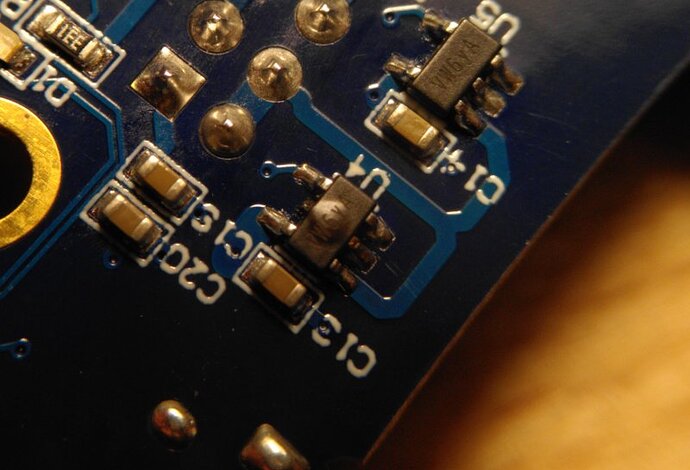Hello everyone,
I have recently damaged a phyWhisperer unit during voltage glitching experimentation.
As it turns out, the +5V high side power switches on the target USB line are not as robust as expected.
The broken part is U4:
The board is Rev 04A.
According to the official schematic, U4 and U5 are AP22802 devices, see sheet #7 in the schematic.
The Diodes Inc. AP22802 “single channel current-limited integrated high-side power switch” matches the description and pinout, and I’ve ordered some AP22802AW5-7 SOT-25 replacement parts after determining that the phyWhisperer needs the Active High = “A” variant.
After swapping the part with some SMD rework, the phyWhisperer target output generally works again in the basic sense that the target power can be switched between “off”, “host” (U4 active) and “5V” (U5 active) again.
However, the new U4 gets hot if the “+5V” source from the control interface is used (=U5 is supplying power, U4 is disabled).
I believe this is due to the built-in “Discharge Function” N-MOS in the AP22802 design that is draining power from the 5V line when the switch is disabled, effectively causing a sort of short for the power that U5 is supplying. This particular switch model is apparently not meant to be combined with other power sources.
I therefore suspect that the schematic is incorrect and that another chip is used which does not have the discharge functionality.
The original IC part is marked “VW 6y A”.
The AP22802 parts are marked “XA 1K B”, which is consistent with the “XA” identification code from its datasheet on page 12.
After some datasheet searching, I believe that the correct part would be the Diodes AP2171A, which is a SOT-25 part with the “VW” identification code. (Active High, 1 channel, 1.5A current limit, AP2171AW-7)
@coflynn, @Alex_Dewar: can you confirm that AP2171A is the correct chip?

 .
.